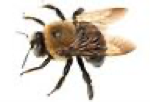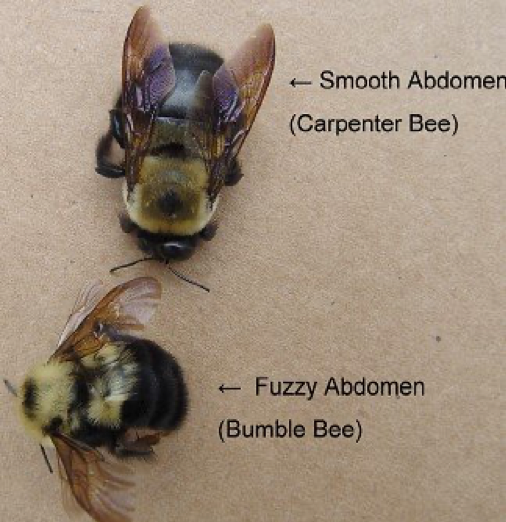
Carpenter bees, affectionately nicknamed “wood bees,” are large, active bees that hover and dart around your property in the spring. Beginning in early spring, they emerge and buzz around. A lot of people find them to be slightly intimidating because carpenter bees aren’t afraid to bump right into you. Luckily, these pesky flyers aren’t known to sting. Their size can be intimidating and comparable to a bumble bee, which can be frightening if you don’t know what you are looking at. Carpenter bees are wood-destroying pests. They are responsible for the perfectly round holes drilled into the fascia boards and eaves of your home, as well as porches, decks, and wooden playground equipment. As a homeowner in Allentown, PA, you should be informed about the dangers are of carpenter bee nesting and damage.
What do carpenter bees look like?
These bees look like large bumble bees, but unlike bumble bees they have a shiny black abdomen. Carpenter bees also have distinctive flight patterns and are often seen diving and darting about and “chasing” each other in flight. They are solitary bees that make nests by chewing perfectly round tunnels into the wood where they lay 6-8 eggs. Many times there will be a brownish stain on the wood directly beneath their nests.
If you see a number of large bees hovering near the eaves of the house or drilling in wood, you have carpenter bees. Generally, they construct their nests in fascia or in trees. Carpenter bees are simply looking for a place to create their nests. While they prefer natural softwoods that are untreated and unpainted, they can (and will) still nest in the wood used to build and side your house, deck, play set, etc.
How can I tell if I have carpenter bees?
Other than seeing the physical carpenter bees, the easiest way to figure out if you have carpenter bees is to identify their damage. Carpenter bee damage is unique. They are drawn to the wood around your home such as the soffits and eaves of your home, your deck, playsets, wooden decks, and other unfinished wood. Pressure treated or painted wood is less susceptible to carpenter bee nesting. They prefer bare wood, don’t be surprised if you find them nesting on your wood-stained deck as the stain isn’t as much as a deterrent as paint. Female carpenter bees drill holes into wood to make their nest and lay larvae. A single female carpenter bee lives in each hole alone, so if you see several holes, several female carpenter bees are likely to be living inside. Although they are not social insects, it’s common to see multiple holes near each other.
Carpenter bees can also attract other unwanted pests. Woodpeckers feed on carpenter bee larvae, which can also cause significant damage to your home as they peck into the existing nests. By preventing carpenter bee activity, you will reduce the likelihood of woodpeckers damaging your home.
Carpenter bees also cause unsightly stains as a result of the nest creation process. They disposed of the wood they chewed through by kicking it out of the hole, inevitably landing below. This staining looks like a mud splatter and is more easily visible when damage is done within the eaves, soffits, or behind shudders when it lands on siding as you can see in the photo below. If you see carpenter bees in your yard but cannot find their nests, finding these characteristic stains can point you in the right direction.
What’s the difference between bumble bees and carpenter bees?
Bumble bees and carpenter bees can often be mistaken for one another, but there is one significant difference in their appearance that will allow you to differentiate the two bees.
- Bumble bees have a hairy abdomen that may have some yellow markings.
- Carpenter bees have a bare, shiny black abdomen.

Along with their difference in appearance, carpenter bees have a very distinct flying pattern. You can see carpenter bees darting and diving around as well as “chasing” each other. Carpenter bees are also primarily solitary bees, whereas bumble bees are social bees that nest together.
Unlike bumble bees, who are social bees that will sting to protect their nest, carpenter bees are solitary. Since they are primarily solitary bees, the female carpenter bees will only sting if seriously provoked.
Entomologist Dr. Richard Cooper said he hasn’t heard of an incident where a person was stung by a carpenter bee, but it is possible. “Male carpenter bees do not possess stingers,” he said. “Female carpenter bees do possess one but they need to be very seriously provoked.”
Dr. Cooper went on to describe why bumble bees readily sting compared to carpenter bees. “Bumble bees will be very aggressive defending their nest,” he said “Bumble bees are social bees so all of their sisters are genetic clones of one another. If a bumble bee were to die because of stinging someone, the bee is a sterile female so it doesn’t affect the reproduction of the bee. However, if a female carpenter bee stings, her reproduction is jeopardized. At that point, her life and reproduction cycle is finished, so the female carpenter bee won’t put herself at risk for that. The bumble bees will readily defend and sting because they have nothing to lose.”
Carpenter Prevention Tactics
If you’re concerned about carpenter bee damage to your Allentown, PA home, there are a few things you can do to deter them from staining and drilling holes into your home.
- Paint or apply wood stains to exposed wood around your property and the exterior of your home. Treating these areas could provide some degree of repellency as opposed to having bare wood.
- If you want to prevent their return, wrap all THREE sides of the board in aluminum or vinyl siding. Do not just wrap the two exposed sides because the bees will nest on the underside of the board. Be sure to wrap the front, under and back side of the fascia board to prevent carpenter bee nesting. Carpenter bees CANNOT chew through aluminum or vinyl, so this will prevent future nesting if all sides are properly wrapped.
- If you are looking to replace damaged wood, don’t just put up new wood since there is nothing stopping the bees from returning. In fact, female carpenter bees often return to the same nesting site year after year if the area isn’t properly addressed.
- Power washing away staining caused by carpenter bees isn’t going to deter them either. The stains are produced in the nest creating process, so without eliminating the bees, their activity will persist.
Unfortunately, there isn’t much that you can do to prevent carpenter bee damage. You can find products that look like little wooden bee “homes” with the promise of natural carpenter bee control. Although some bees may be attracted to these homemade traps, there is absolutely nothing stopping them from targeting the typical nesting sites on residential properties such as decks, fascia boards, soffits, behind shudders, wooden decks, and more. Because carpenter bees are solitary (living alone in a single nest), you will not be killing off any sort of colony.
If you are seeing carpenter bee damage on your Allentown, PA home, give us a call to learn more about our carpenter bee removal and control plans.
Carpenter Bee Information for Allentown, PA Homeowners Pest Control in Pennsylvania & New Jersey
Serving Northeast & Central PA | Lehigh Valley | Pocono Mountains | Western NJ
